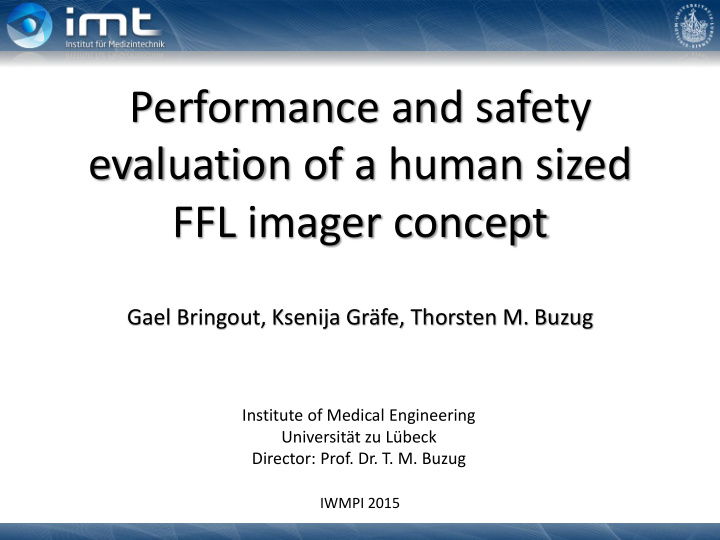



Performance and safety evaluation of a human sized FFL imager concept Gael Bringout, Ksenija Gräfe, Thorsten M. Buzug Institute of Medical Engineering Universität zu Lübeck Director: Prof. Dr. T. M. Buzug IWMPI 2015
Motivation - I Two effects limit the Field Of View (FOV) for a Human sized FFL imager: • the drive field amplitudes are limited to a few mT due to Peripheral Nerve Stimulation (PNS), • the low field volume looks like a banana when moving the line near the border of the coils. 2
Motivation - II How could we increase the FOV? With which sequence? Does the banana effect play a significant role? Are PNS likely to happen? 3
Which imager? Higor Scanner with a 1 T/m gradient on the line: Quadrupoles: • Inner diameter: 1 m • Magnetomotive force: 81 kAT • Current density: 3 A/mm² Solenoid: • Inner diameter: 0.7 m • Length: 1.5 m Dissipated power: 2 ∗ 65 kW • Drive: • 2D Inner diameter: ~ 0.50 m • Focus: • Using the pole of the quadrupole • Current density: unknown 4
An FFL sequence using focus fields In order acquire one image with a fully resolved spectrum we: • move the rotation centre 3 times around the Lissajous curves, • rotate the line 2 times using a 2π rotation. The Lissajous curve is made with frequencies of 90 and 60 Hz. Quadrupoles are used with a frequency of 40 Hz. 10 acquisitions per second. 5
Reconstruction • Area divided in 25 sections (limited by the available RAM – 1 TB) • Reconstructed with a modified ART ( filter imaginary & negative solutions ) • No regularization 6
Signal structure With a drive frequency of 150 kHz, the system matrix looks like: 300 010 Hz 302 040 Hz 306 100 Hz 308 620 Hz 312 890 Hz 304 100 Hz The simulated signal for a section looks like: 7
Signal amplitude Using the FC with an SNR above 1/10 of the maximal SNR around the 3rd harmonic (the red one), 572 FCs are selected. 8
Safety: Can we put a patient inside Higor? Drive coils • 3.7 & 4.8 mT Amplitude peak • 150 kHz • Ok Quadrupole • 0.5 T/m • 40 Hz • ~ 3 V/m: Reilly 1991 – could be ok Focus • 320 mT peak • ~ 90 Hz 7 V/m • ~ 32 V/m: Reilly 1991 – not ok And together? 9
Future work Explore other possibilities: • reduce the focus fields amplitudes, • reduce the drive frequency. 25 kHz Improve the concept by: • generating enough magnetic fields for the focus fields. Saturation of the core is a limiting factor, • experimentally defining the PNS thresholds for low frequencies, • experimentally defining the PNS thresholds for a sum of fields & frequencies. 10
Conclusion 300 010 Hz For a human sized FFL imager using focus fields and the presented sequence: • a large FOV can be covered, • current functions are continuous, 302 040 Hz • 10 images per second could be acquired, • field quality is not an issue • more knowledge about the PNS thresholds should be gathered, 312 890 Hz • flexibility on the choice of frequencies, huge impact on MPI-signal structure. 11
Thanks – Questions? 13N11090 122-10-004 BU 1436/9-1 01EZ0912 ER 777/1-1 13EZ1140A BU 1436/7-1 13GW0069A BU 1436/10-1 604448 03EFT6SH12 DFG GSC235/2
Low and high frequencies mixing • Does it work as simulated? 13
14
150 kHz 25 kHz 15
Some reco parameters • Langevin particle – 30 nm – Fe304 • Concentration phantom: 1.5 mol. m −3 (Resovist, 10 times diluted) noise's amplitude spectral density: 56 pV/ Hz • – 30 times more than the patient noise limits from Weizenecker 2007 – A simulation study […] • Resolution: – System matrix: 1 mm – Phantom: 0.5 mm 16
Recommend
More recommend